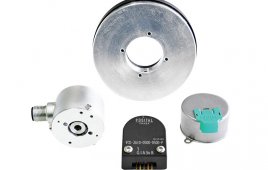Most double-feed induction generators require encoder feedback for top performance and line synchronization. But the high vibration and temperature extremes kill even “heavy duty” optical encoders. Recent encoders have been designed for wind turbine applications. The devices indicate the angular position of a rotating shaft and are often described as incremental or absolute. But there are variations.
Incremental encoders need an input voltage, often between 5 and 30 Vdc. The design is similar to a rotary switch in that it is on or off, so the output is either 0 or the input (supply) voltage. When supplying an encoder with 5 Vdc input, that will be the high output voltage, so its output is always a square wave. These are further identified in terms of pulses per revolution (ppr). A common incremental resolution is 1,024 ppr. So for every complete rotation, the encoder produces 1,024 pulses. Another common resolution is 2,048 ppr, although incremental encoders come in resolutions from 1 to 10,000 ppr. Most wind-turbine applications will be 1,024. On the generator, however, expect 3,072 ppr with each pulse exactly the same. A controller would count the number of outputs to know a shaft’s position.
Absolute encoders are a bit different. Their output data is relative to their position. They output a unique digital “word” for each individual position. They also output in several different field-bus-communication protocols. Instead of using pulses-per-revolution to describe their resolution, they use bits instead of pulses. So an absolute encoder may have an output described as 10 bits. A common application is inside the turbine hub on pitch control units. Encoders are either sandwiched between pitch motors and brakes or on the back ends of motors. Shafted encoders are picked for these applications as well as hollow-shaft devices.
An important element to keep in mind when looking at encoders for these applications is the temperature spec. It’s not surprising that encoders sandwiched between motors and brakes get hot, so make sure the selected device can tolerate the heat. Specs up to 130°C are not unusual. When they get hot, several things can happen. For one, glued components can come apart and cause the device to fail. Also, signal quality can be affected by extreme heat causing the drive system to misunderstand the position reported by the encoder. These failures can be avoided by understanding the encoder’s capabilities. Another wind-turbine application is on the end of a generator. Encoders there are used to regulate speed and, in some cases, determine position. Like the feedback used on pitch systems, generator feedback applications are considered mission critical. If either of these feedback applications fails, the turbine cannot produce power.
Also expect encoder problems on those with undersized bearing on a generator. Failed bearings are the number one cause of generator-encoder failures. Electrical and thermal isolation further enhances feedback reliability. One OEM uses a pulse encoder on each rotor blade and one to track where the turbine is pointing. The main control system uses position information to optimize generator speed relative to wind speed and direction. It is essential to use reliable components because wind turbines are sited in areas with large temperature fluctuations. In addition, many wind turbines are headed offshore, so their components must be reliable, otherwise servicing and maintenance costs can spiral out of control.
Magnetic hollow-shaft encoders provide a third type. They are hermetically-sealed magnetic encoders, heavy-duty devices said to detect wear and maintenance issues. One line of these can mount to generator shafts up to 740-mm diameter, yet has only a 27-mm profile. These encoders provide 17-bit single-turn resolution, for accurate speed, rotation, and position data even at low turning speeds. Of the recent encoders, one version for generators is intended for harsh conditions. It features optical ASIC and encapsulation technologies for long-term resistance to dust, water, heat, mechanical shock, vibration, and more. Features include a phasedarray sensor for reliable signal output, wide-spaced oversized bearings, an unbreakable code disc (up to 5,000 ppr), an improved seal for increased moisture resistance, an extended temperature range of -40 to +100°C, and IP67 enclosure rating.
Another recent encoder line fits existing shafts and flanges of all major generator manufacturers, yet are said to have greater durability. These models are pin-for-pin electrically interchangeable with existing models from many manufacturers. The encoder manufacturer says it uses bearings rated for over 5X greater loads, and its magnetic sensors shrug off dirt, grease, condensation and oil. Protection from all wiring errors is standard. Local and remote predictive diagnostics let technicians quickly determine if the encoder is working, and more important, detect problems before they can cause a generator trip.
Filed Under: Encoders





